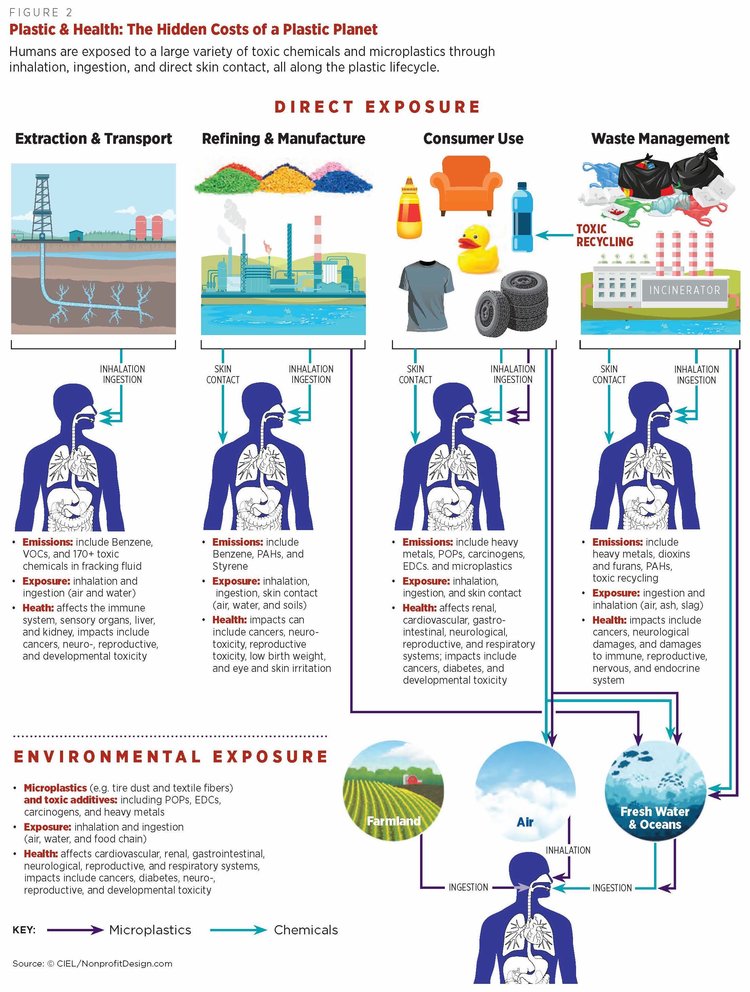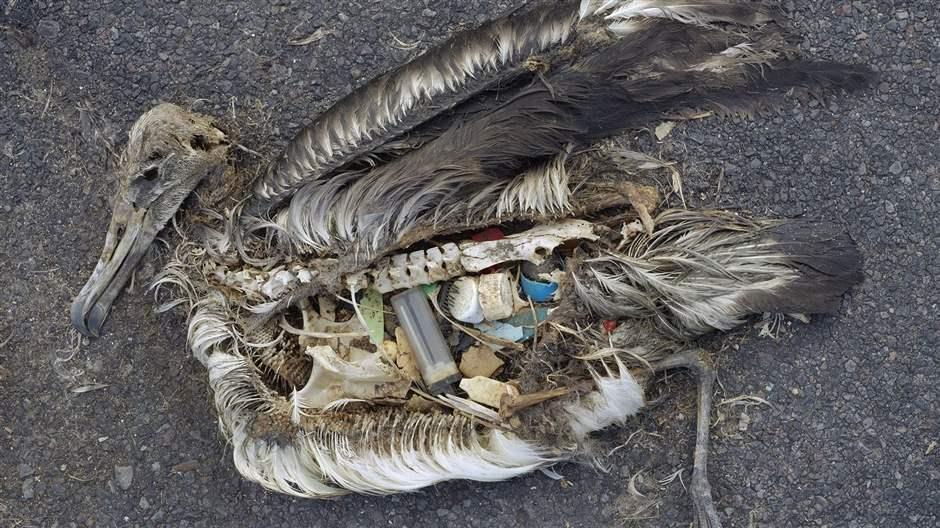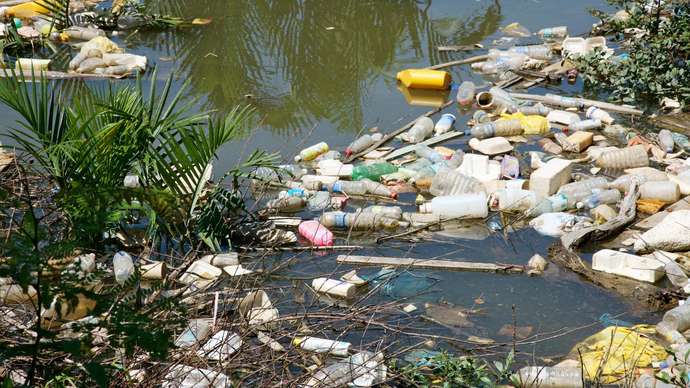Introduction
The build-up of synthetic plastic products in the surroundings to the extent where they constitute a threat to wildlife, and their habitats and humankind is referred to as plastic pollution. Plastics can be classified either in primary plastics, for instance, cigarettes butts, bottle caps, or secondary plastics, that is, those waste resulting from the degradable primary plastics (Rhodes, 2018). Plastics can also be grouped by size, from microplastics to macro-plastics. Microplastics are tiny particles of plastic waste, usually less than five millimeters, while microplastics are large plastic wastes. There are two significant sources of plastics: natural gas and crude oil. In 2004, most plastics were derived from natural gas and crude oil in large quantities, such as 8.3 billion tonnes, making them globally available (Rhodes, 2018). Since Natural gas and crude oil are gases, they are broken into monomers later combined in polymerization, resulting in polymers. Globally, the effects of plastic pollution on health, environmental impacts, and sources of plastic loads are very evident.
Increased Pollution Loads of Plastic
The first plastic product, Bakelite, was invented as early as 1907, thus bringing a new revolution of truly synthetic plastics resins into the world (Moore, 2021). By the twentieth century, it is evident that plastic products have been over-manufactured since they are locally, internationally, and globally available (Morgan et al., 2019). Due to their availability in large quantities, their uncontrolled disposal has led to environmental pollution ignorance by human beings being the primary catalyst.
There has been a significant rise in the carbon dioxide concentrations in the atmosphere contributed by human activities and natural sources in the recent past. Human origins, unlike natural sources, contribute a smaller percentage of carbon dioxide in the atmosphere but have altered the natural balance existing some millennials ago (Yao et al., 2020). The primary human activities that have led to the increased concentration of carbon dioxide in the atmosphere are burning coal, gas and oil, and deforestation (Martin et al., 2019). Out of all human-produced carbon dioxide emissions, 87% emanate from the burning fossil fuels (coal, natural gas, and oil). The remaining 13% is a change of land use and clearing of forests.
The most significant percentage of carbon dioxide is contributed by natural emissions, which ensure a natural balance of carbon dioxide exists in the atmosphere. This natural balance exists since natural sources contribute to the carbon dioxide emissions into the sky and, at the same time, absorb the excessing carbon dioxide from the environment (Galloway et al., 2020). This is the significant difference between human and natural sources since human sources do not absorb any of the excessing carbon dioxides emitted in the environment, thus upsetting the natural balance. Decomposition, ocean discharge, and respiration are all-natural sources of carbon dioxide emissions.
Health Impacts
Plastic pollution can impact land, waterways, and human health by hurting wildlife and habitat. Despite being one of the world’s most frequently used materials, little is known about the health implications of plastic. Plastic is rising in new sectors of the environment and food chain as plastic goods fragment into small particles and concentrate hazardous substances. This exposure will only increase as plastic manufacture rises. There are significant effects on human health that occur in every stage of plastic’s lifecycle, from the very first stage of plastic manufacturing up to the last stage, that is, from waste management to the ongoing effects such as air, water, and soil pollution, according to extensive research on plastic’s impact on human health (Schlachter, 2019).
If each stage of plastic’s life cycle is right from the manufacturing stage to the final one, that is, distribution of the plastics, then it is possible to account for most of the unique risks of plastics (Jacobson et al., 2019). The majority of people are prone to these effects of plastic pollution since there are multiple lifecycles:
- The chemical compounds produced during the extraction and transportation of fossil feedstocks are very catastrophic. Once released into the environment, these compounds play the most significant roles in causing cancer-related diseases, posing a danger to human life (Jacobson et al., 2019).
- Similarly, the carcinogenic and other deadly compounds produced during the production and refining process cause health complications like cancer, immune system impairment, and other genetic complications, once released to the environment.
- During packaging the plastic products, the toxic chemicals from the plastic are inhaled, thus causing health issues to the people involved.
- During processes of plastic waste management, such as recycling plastic waste into energy and other incinerations, harmful products are released into the environment, causing direct or indirect health dangers to human beings, animals, and neighbors around (Alabi et al., 2019).
- Microplastics and fragmentation, whose direct entry into the human body causes a series of health problems connected to numerous adverse health outcomes, including heart failure, cancer, and autoimmune conditions.
- Plastic pollutes and aggregates in food systems, creating additional dangers to humans through agricultural fields, terrestrial, and marine food chain cycles, and the water system. As plastic degrades, harmful compounds concentrated in plastic are released into the environment and people’s bodies, resulting in a cascade of exposure.
Below is an illustration showing how these hazardous compounds released from plastics enter into the human body, and the resultant effects.

Plastic garbage that has been improperly disposed of, recycled, and abandoned in landfills is eventually swept away by the winds and pushed into sewers, streams, and rivers, finally getting in the oceans, and seas. The deadly effects of poisonous plastics are slowly ruining our marine and marine lives. For instance, a gray whale was trapped dead only to find that its death was caused by plastic trash trapped inside its stomach (Barupal et al., 2019).
As per United Nations statistics, at least 800 species are harmed by marine garbage, with plastic taking the most significant percentage of the waste (Ragossnig & Agamuthu, 2021). An approximation of 13 million metric tons of plastic is expected to enter the ocean every minute, corresponding to trash or rubbish lorry (Carney Almroth & Eggert, 2019). When marine animals become entangled or ingest plastic rubbish, Suffocation, malnutrition, and drowning are possibilities. This danger isn’t just for humans: While plastics take hundreds of years to dissolve fully, minuscule particles result from some of these plastics after partial decomposition, which eventually ends up in the seafood we eat (Van der Maesen, L. J. 2018). Below are pictures illustrating marine pollution and its corresponding effects for easier understanding (Moore, 2021)


Environmental Effects of Plastic Pollution
Plastic waste has been vastly distributed in urban areas and trade routes by several elements like winds and ocean currents. Depending on the population density in some regions, plastics can be vectors for toxic elements such as persistent organic pollutants and trace metals. During the manufacturing process of plastics, toxins leak to the environment, which contributes the adverse effects to the surroundings. In the process of manufacturing plastics, carcinogenic, neurotoxic, and hormone-disrupting chemicals are constituents of waste products that always find their way to the environment via elements like water and air (Khaimar et al., 2019).
Vinyl chloride (in PVC), dioxins (in PVC), benzene (in polystyrene), phthalates and other plasticizers (in PVC and others), formaldehyde, and Bisphenol-A, or BPA, are some of the most well-known substances (in polycarbonate) (Ahmed, 2021). Many of these substances are resistant to organic toxins, the most deadly toxins due to their long-term endurance in the surroundings and significant toxicity levels. Their unrestricted discharge into the environment impacts any terrestrial and aquatic life that comes into contact with them (Gomeseria, 2019). Various toxic gaseous chemicals are released into the surrounding during the production process, exceedingly harmful to the environment.
High quantities of these gases in the air are hazardous to healthy human tissues. They can cause breathing ailments, neurological system abnormalities, and a decline in disease immunity. Plastic passed through chlorination can leak dangerous chemicals into the soil, seeping into groundwater or nearby water sources, harming the environment and the ecosystem. The species that depend on the water may suffer catastrophic consequences. Many different forms of plastics can be found in landfills. Many microorganisms in these dumps fasten the biodegradation of plastics, including Pseudomobacteria, nylon-eating bacteria, and Flavobacteria. The nylonase enzyme in these bacteria is responsible for breaking down nylon.
Methane is generated by decomposing biodegradable plastics, a potent greenhouse gas contributing significantly to global warming (Gomeseria, 2019). Aside from the consequences listed above, some scientists believe that floating polymer fragments in the water may cause climate change by forming a darker canopy that makes plankton development difficult. The kingdom Plantae is the most extensive carbon section on the planet. Plastic garbage pollutes our rivers, and we have a severe problem. We frequently dispose of waste plastic products in our waterways and reservoirs. Visitors commonly threw plastic bottles, cans, bags, and other plastic objects may be the best evidence of pollution in the megacity of Dhaka’s lakes. Plastic garbage disposal in waterways disrupts natural flow, restricts fish reproduction, and eliminates beneficial bacteria.
Remediation and Pollution Reduction
Since plastic pollution has catastrophic consequences for human health and the ecosystem, there is a great need to employ strategies to control plastic disposal and reduce plastic pollution. Below are solutions that may lead to a reduction in plastic pollution.
- Reduction of plastic usage: Plastic pollution could be mitigated by minimizing plastic usage or embracing alternatives. A behavioral change could play the most significant role, such that people cannot use plastics when there is a better alternative and using plastics in exceptional circumstances.
- Employing the art of reusing plastics: Benefits of plastics outshines their disadvantages; however, plastics can significantly pollute the environment if handled recklessly. Therefore, most plastic waste could be reused or adapted to fit new uses in the economy (Horejs, 2020). It is critical to explore how plastic items can be repurposed before discarding them.
- Recycling plastics: To control the quantities of plastic dumped in pits and rivers or oceans, plastic waste could be recycled. Plastic recycling is converting plastic waste to other new products used for different purposes.
- Educating the public on plastic disposal and effects: Education that passes knowledge to the naïve and the uninformed can act as the primary solution, thus helping to raise awareness and influence behavior.
Conclusion
Plastic toxicity is an issue globally, affecting everyone from individuals to entire populations. The study demonstrates that vulnerability to harmful chemicals used in the manufacture of plastics has detrimental repercussions for human health, and the environment. In most studies, plastic is dangerous health-wise to humans, and their surroundings. The country’s government should take additional actions, law enforcement agencies, and health authorities to guarantee that plastics are manufactured, used, and disposed of sustainably. High-risk phthalates should be outlawed and supplemented, especially in consumer products and those that come into touch with children. Bisphenols should be banned in materials that accompany foodstuffs, beverages, and children, and other consumer products such as thermal cash receipts in the long run. Every organization must accept responsibility for minimizing excessive plastic consumption. A comprehensive list of all chemicals found in consumer products must be needed to utilize them.
References
Ahmed, A. M. Z. (2021). Achieving sustainability in the design of Plastic Products. International Design Journal, 11(3), 47-57.
Alabi, O. A., Ologbonjaye, K. I., Awosolu, O., & Alalade, O. E. (2019). Public and environmental health effects of plastic wastes disposal: a review. J Toxicol Risk Assess, 5(021), 1-13.
Carney Almroth, B., & Eggert, H. (2019). Marine plastic pollution: sources, impacts, and policy issues. Review of Environment Economics and Policy, 13(2), 317-326.
Gomeseria, R. V. (2019). Future of Engineering within the Ecosystem. ViewPoint Journal June Edition.
Horejs, C. (2020). Solutions to plastic pollution. Nature Reviews Materials, 5(9), 641-641.
Jacobson, T.A., Kler, J.S., Hernke, M.T. et al. Direct human health risks of increased atmospheric carbon dioxide. Nat Sustain 2, 691–701 (2019). Web.
Martin, C. R., Zeng, N., Karion, A., Mueller, K., Ghosh, S., Lopez-Coto, I., Gurney, K.R., Oda, T., Prasad, K., Liu, Y., Dickerson, R.R & Whetstone, J. (2019). Investigating sources of variability and error in simulations of carbon dioxide in an urban region. Atmospheric environment, 199, 55-69. Web.
Moore, C. (2021). Plastic pollution. Encyclopedia Britannica. Web.
Morgan, W. T., Darbyshire, E., Spracklen, D. V., Artaxo, P., & Coe, H. (2019). Non-deforestation drivers of fires are increasingly important sources of aerosol and carbon dioxide emissions across Amazonia. Scientific reports, 9(1), 1-15.
Ragossnig, A. M., & Agamuthu, P. (2021). Plastic waste: Challenges and opportunities. Waste Management & Research, 39(5), 629-630. Web.
Rhodes, C. J. (2018). Plastic pollution and potential solutions. Science progress, 101(3), 207-260. Web.
Schlachter, C. T. (2019). Is it time to ban single-use plastic? A look at microplastic in our food and water supply.
Van der Maesen, L. J. (2018). Addressing Marine Plastic Pollution: The Plastic Soup Foundation and the Four-Dimensional Application of the Social Quality Approach. The International Journal of Social Quality, 8(2), 47-77.
Yao, Y., Ivanovski, K., Inekwe, J., & Smyth, R. (2020). Human capital and CO2 emissions in the long run. Energy Economics, 91, 104907. Web.
Zhou, Y., Wang, J., Zou, M., Jia, Z., Zhou, S., & Li, Y. (2020). Microplastics in soils: A review of methods, occurrence, fate, transport, ecological and environmental risks. Science of The Total Environment, 748, 141368. Web.